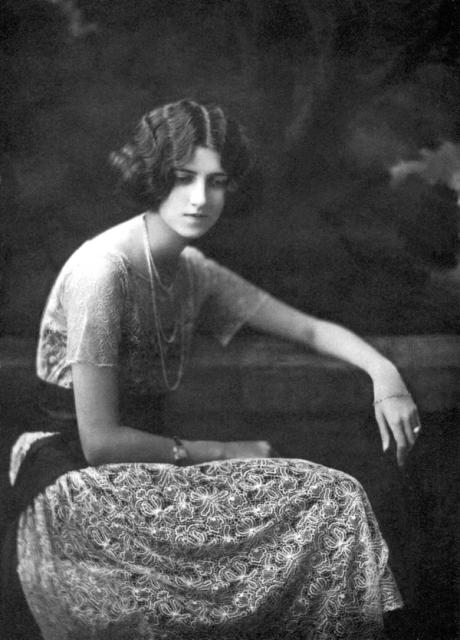
Peggy Guggenheim (1898-1979), as readers of The Art Newspaper will know, is the Venice one and not the New York one, though shortly before her death she gifted her unfinished palazzo and her collection, including the Marini horseman with the famously detachable phallus, to the foundation set up by her uncle Solomon. She lived at the heart of the 20th century: from her father’s death on the Titanic; via her pioneering achievements as a patron and gallerist, showing avant-garde works in innovative spaces and nursing Abstract Expressionism into being, devoting a show, 31 Women, to contemporary female artists for possibly the first time anywhere; to a partly peaceful third act (marred by her daughter Pegeen’s suicide, after many attempts, in 1967) in Venice, which had, by the time she moved there after the Second World War, regained its ancient status as a cultural pilgrimage site.
Reputations and estimations—gossip, in the wrong hands—loom large in any account of Guggenheim’s life. Her mother’s side of the family looked down on her father’s for having made their money in industry rather than on Wall Street; rich gentiles looked down on all of them equally. Her father spent freely, and slept around; not much in his life became him like the leaving of it, as he tucked a rose in his lapel, lit a cigar and went down with the ship. Guggenheim’s sister, Hazel, was suspected of dropping her two children off the top of a building. Pegeen would show up in the middle of a dinner party covered in blood.
Guggenheim’s own robust sexual appetite (“I whispered then,” she says in the present book, “I said the words like a vow: I am—I am—a libertine”) and sometimes tangled personal life, coupled with the simple fact of her wealth, made her a target for moochers and freeloaders. Her first husband—Laurence Vail, the “King of Bohemia” and Pegeen’s father, a writer and artist of modest achievements (though he did write a roman à clef about their marriage, which I would not mind hunting down some time, fetchingly titled Murder! Murder!)—did not always treat Guggenheim kindly.
Art-world tabloid fodder
There is a belief afoot that Guggenheim has been turned into the art-world equivalent of tabloid fodder, to the detriment of her accomplishments. Numerous attempts have been made to set the record straight, from her own Out of This Century: Confessions of an Art Addict (1960) and Mary Dearborn’s Mistress of Modernism (2004) to various documentaries and the endless excitable blogposts I came across while working on this review.
And now, along comes Peggy. The novel is rounded with a couple of sad notes: Rebecca Godfrey worked on it for ten years, but died of cancer before she could finish it; Leslie Jamison was commissioned to finish it by her agent. The acknowledgements, of which there are several, were partly dictated by Godfrey to her husband, Herb Wilson. All in all, you would have to be some kind of monster to criticise it. But, as Samuel L. Jackson so nearly says in Jackie Brown: I gots to be that kind of monster.
There is nothing particularly wrong with the execution, though it is done in a clotted baroque style that is an odd fit for a woman who championed Modernism: who sat for Man Ray (dressed somewhat like a fortune teller, admittedly), bought Berenice Abbott her first camera and ripped the rococo boiseries out of her apartment in the Place Vendôme in Paris. Dialogue is not flagged typographically, so you are constantly reading things and wondering whether someone is saying them, or Guggenheim is thinking them. The goal, I suppose, is to bring the innermost self of the subject to life, to redeem Guggenheim from the belittling scrutiny of others; but we are so constantly swept along in the torrent of her thoughts that we do not get much sense of what she thinks about anything, be it art, sex or Paris (“I felt as if I was walking into a painting,” she says, bathetically).
Guggenheim’s complicated relationships with and contradictory feelings about family, friends and lovers come across pretty vividly, it has to be said. But we have all got those. What is surely interesting about her (and what can indeed be occluded by focusing too narrowly on her nose job, her amorous marathon with Samuel Beckett and so on) is what she did. The action of Peggy concludes on the threshold of triumph, with the opening of her Cork Street gallery in 1938; then there is a brief epilogue (written by Jamison) in Venice. So no 1940s New York, no green-card marriage with Max Ernst, no Art of This Century, her gallery on West 57th Street with its startling Bond-villain aesthetic, no Dorothea Tanning (who exhibited in 31 Women and duly caught Ernst’s wandering eye), no Jackson Pollock widdling in the fireplace, no fallings out with uncle Solly’s artistic consigliere Hilla Rebay.
Equally, there is nothing about Pegeen’s tragic adult life, or Guggenheim’s slanderous hounding of her son-in-law, Britain’s foremost Situationist Ralph Rumney, who she blamed for Pegeen’s death. Instead, we have a skilful enough take on a wearyingly familiar trope: a rich American cutting loose in the Old World. At least she does not complain about the plumbing.
- Rebecca Godfrey with Leslie Jamison, Peggy: A Novel, John Murray, 384pp, £18.99 (hb), published 15 August
- Keith Miller is an editor at The Telegraph and a contributor to Apollo magazine and The Times Literary Supplement










